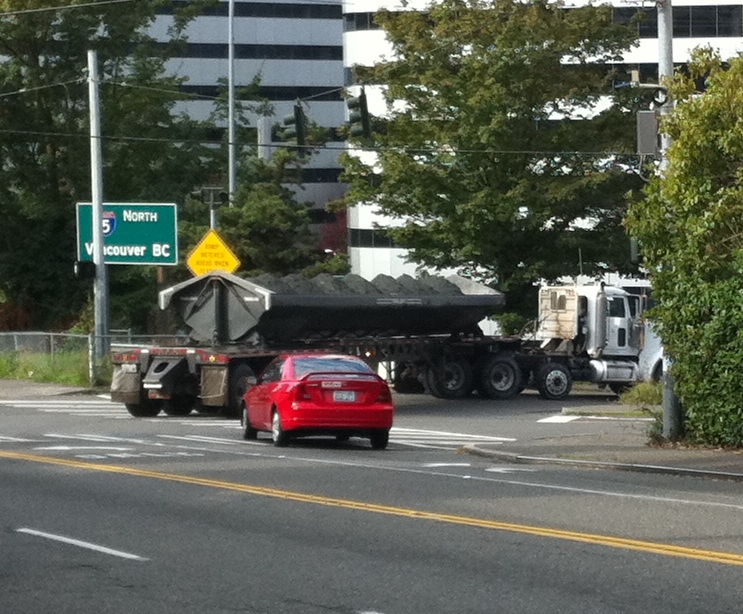 Kind of funny how easy it is for the most massive public works project in generations on Capitol Hill to get lost in the shuffle. Here’s the latest on what’s going on around Sound Transit’s University Link light rail and Capitol Hill station project. Have a question you’d like us to look into related to the Big Dig? [email protected]
Kind of funny how easy it is for the most massive public works project in generations on Capitol Hill to get lost in the shuffle. Here’s the latest on what’s going on around Sound Transit’s University Link light rail and Capitol Hill station project. Have a question you’d like us to look into related to the Big Dig? [email protected]
- Extensometers Below: Back before the snow, you might have noticed a big white truck with a big drill making relatively small holes along East Pine. You can see one of the finished products in the pictures on this post. Given new sensitivities to what is underfoot on Seattle city streets, we thought you’d like to know that, when you walk across one of these caps, you’re standing atop a shaft above the path the future light rail tunnels will travel between the Hill and downtown.
The shafts house sensitive monitors from a company called GEO-Instruments. These extensometers are being used to monitor any changes in the position of soil above the tunnel route. “We place them along the entire tunnel alignment to measure any surface settlement above the tunnels during construction,” Sound Transit spokesperson Bruce Gray tell us. Here’s what Wikipedia has to say about extensometers:
In the mining environment, extensometers are used to measure displacements on batters/highwalls. Plotting displacement vs time enables Geotechnical engineers to determine if wall failures are imminent. For complicated failures, further equipment such as radar or laser scans are used enabling 3-dimensional and ultimately 4-dimensional analysis.
Gray says that description is “a little dramatic” but says, basically, the same purpose is being served along Pine.
- Capitol Hill station status: We haven’t seen any sign of the big giant crane that is supposed to grace our skyline for a few years starting soonish but maybe we’ve missed its early appearance. Meanwhile, the project schedule had called for the the station box’s excavation to be completed and its 10 feet of concrete to be poured by now.
- Where does all that Capitol Hill dirt end up? With about 50,000 cubic yards of dirt removed from Capitol Hill so far, we wondered where the soil was ending up. So we can claim the new territory for our own, naturally. Sound Transit tells us that their contractors “own” the dirt they excavate and control where and how it’s disposed per contractual requirements that keep it from being disposed of improperly. The contract is set up that way so that the contractor assumes the risk of changing disposal costs, not Sound Transit. A contractor will typically use multiple disposal sites due to variability in material properties, fluctuations in the market, Sound Transit tell us. One current destination is the AAA Monroe Rock Quarries site located at 15421 166th Street in Snohomish.
View Larger MapWelcome to our new readers in Snohomish.The disposal of spoils from projects like this has also spawned some e-commerce you might not have known about. Dirtfill.com matches businesses that need dirt with contractors who can provide it. Add it to your holiday shopping bookmarks.  How the dirt gets there: Now that we know where the dirt is going, what about how it travels to the site? A question from CHS reader Michael:
How the dirt gets there: Now that we know where the dirt is going, what about how it travels to the site? A question from CHS reader Michael:
I saw your recent post on the number of Sounds Transit trucks coming and going from the Capitol Hill dig. There is something that’s been bugging me about those trucks and so I am wondering if you’d be interested in inquiring with Sound Transit and blogging about it. The dump trucks leaving the worksite are loaded to the top with dirt (pic attached) and I have yet to see one that is actually covered, despite some trucks that have built in covers.
As the trucks proceed down the hill and enter the freeway, it occurs to me that there are laws about covering loads on highways. Recent injuries and deaths have prompted the legislature to increase the penalties for unsecured loads. While trucks carrying dirt are not required to cover if they maintain 6” of freeboard, I still think the heaping mounds of dirt that rise above the edge of the trucks have a high potential to throw dirt and rocks onto unsuspecting motorists.
Does Sound Transit have any concern about this practice of not covering their loads?
Sound Transit’s Gray says, “We have no way of knowing if that was one of our hauling contractor’s trucks but our folks say that truck appears to be operating within the rules for hauling materials. We have inspectors on site making sure every truck that leaves the site is compliant with all applicable laws.” Sound Transit says contractors are required to comply with all applicable permits, regulations, and laws when disposing of this material. In other words, this might not have been a truck related to the Capitol Hill project, but if it was, Sound Transit says it is operating within the law.
- You can tune into light rail station and tunnel construction on the CHS Construction Cam page http://capitolhillseattle.com/lightrail




Now this is the kind of Sound Transit trivia I can get behind!
It’s cool to see that Capitol Hill is “expanding its territory” to the Northeast, so to speak. Maybe we should organize a field trip to visit our former dirt.